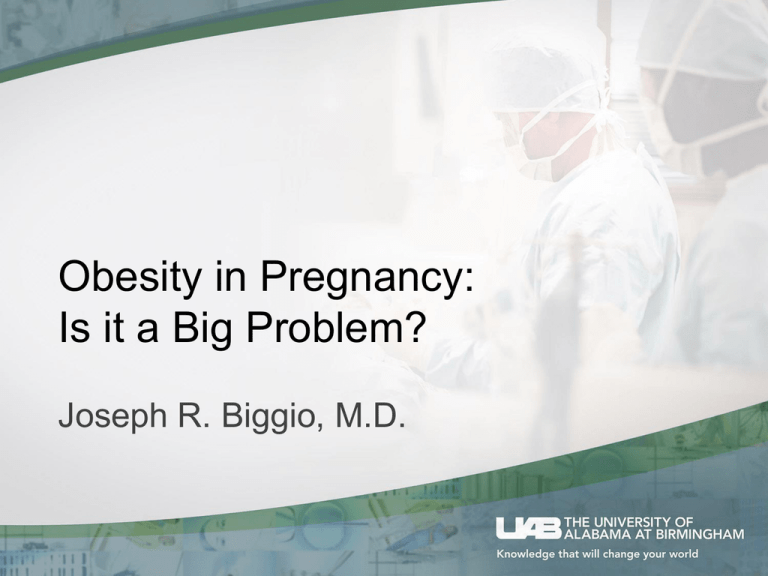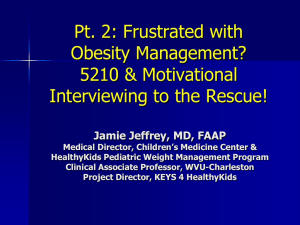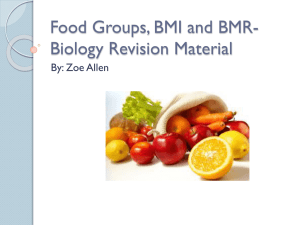
Obesity in Pregnancy:
Is it a Big Problem?
Joseph R. Biggio, M.D.
Objectives
• Become familiar with the physiologic alterations
in obese pregnant women
• Understand the medical and obstetric
complications associated with obesity in
pregnancy
• Become familiar with long-term consequences
of maternal obesity for the woman and her
offspring
• Discuss risk-reducing strategies for obesityrelated complications
Obesity
• Major medical and public health
problem
• Significant morbidity and mortality
• Health care expenditures:
• By 2030, 16-18% of all healthcare
expenditures related
Wang et al, Obesity 2008
Obesity Trends* Among U.S. Adults
BRFSS, 1990, 2000, 2010
(*BMI 30, or about 30 lbs. overweight for 5’4” person)
2000
1990
2010
No Data
<10%
10%–14%
15%–19%
20%–24%
25%–29%
≥30%
Obesity Among U.S. Adults
BRFSS, 2013
WA
MT
OR
ME
ND
ID
MN
VT
SD
WI
IA
NE
NV
PA
IL
UT
CO
MO
OK
NM
KY
AR
SC
TX
AL
GA
LA
FL
HI
GUAM
15%–<20%
20%–<25%
25%–<30%
30%–<35%
≥35%
VA
NC
TN
MS
AK
OH
IN
WV
KS
CA
AZ
NY
MI
WY
PR
NH
MA
RI
CT
NJ
DE
MD
DC
Obesity in Women
BMI
25-29.9
30-39.9
>40
2001-02
28.2
33.2
6.5
2011-12
29.7
36.1
8.3
NHANES, Health E-Stat, Fryar et al, CDC
NCHS, Sept 2014
Obesity: Race/ethnicity effect
Non-Hispanic White
Non-Hispanic Black
Asian
Hispanic
2011-12
32.8
56.6
11.4
44.4
• 75% of AA women BMI >25
NHANES, Health E-Stat, Fryar et al, CDC
NCHS, Sept 2014; NCVS, Flegal et al, 2010
Economic Costs—Medical Care
• Increased utilization of resources
• Prenatal visits
• Ultrasounds and fetal surveillance
• Medications dispensed
• Increased
• Comorbid conditions
• Hospitalizations
• Prolonged hospital stays
• Maternal and neonatal ICU admissions
• Adds approximately $5.4-6 billion annually in
healthcare cost in UK
Chu et al., NEJM, 2008; Heslehurst, Obes Rev 2008;
Dennison et al., BJOG. 2009
Physiologic Changes: Cardiovascular
• Blood volume, Cardiac output increase in
proportion to fat and tissue mass
• CO increase 30-35 ml/min per 100 gm fat
• Diminished progesterone-induced vascular
compliance
• Increase risk for LV hypertrophy
• Intimal hyperplasia and medial thickening
Veille JC et al, AJOG 1994; Perlow J, Obstetric
Intensive Care Manual, 2003
Physiologic Changes: Pulmonary
PO2, chest wall/lung compliance
• 50% lower compliance than non-obese
• Work of breathing 3x higher than normal
• Risk for sleep apnea
• Pulmonary hypertension
Juvin et al, Anesth Analges, 2003; Perlow J, Obstetric
Intensive Care Manual, 2003
OSA, Co-morbidities & Outcomes
50
44
40
33
30
OSA
30
20
10
Obese
11
9
3
9 8
Normal Wt
1
58
60
0
CHTN
Diabetes Asthma
50
40
40
30
20
10
30
19
11
7
10 12
15
12
1 4
0
Pre-E
<37 wk
<32 wk
Cesarean
Louis et al, AJOG 2010; 202(3):261
Antenatal Complications
• Infertility
• Spontaneous Abortion
• Congenital Malformations
• Perinatal Mortality
Infertility
• Fecundity reduced
• Overweight
8%
• Obese
18%
• Possible Etiologies
• HPO axis disruption
• Increased leptin
• Insulin resistance with androgen, SHBG
•
fat, estrone
• Endometrial abnormalities
Gesink et al, Hum Repro, 2007; Pasquali et al, Hum Repro
Update, 2003; Haslam, Lancet, 2005
Spontaneous Abortion
• Increased loss rate
OR 1.7 (1.3 – 2.3)
• After ovulation induction:
OR 5.1 (1.8 – 14.8)
• ? Related to estrogen and luteal phase
defect with progesterone
• ? diabetes
Metwally et al, Fertil Ster, 2008
Congenital Anomaly and Obesity
• Multiple studies demonstrate increased risk
• Multiple different types involved
• Dose-response relationship
• Undiagnosed diabetes suggested as potential
contributor
Stothard et al, 2009; Shaw et al, 2008;
Biggio et al, 2010
Obesity and Anomalies
NTD
Cardiac
Cleft
Anal atresia
Cystic kidney
Omphalocele
BMI ≥30
2.04 (1.5-2.7)
1.17 (1.1-2.2)
1.26 (1.1-2.0)
1.87 (1.4-2.5)
1.40 (1.0-1.9)
2.03 (1.4-2.9)
Blomberg & Kallen, 2010
Dose-Dependent
BMI 30-34.9
35-39.9
≥40
NTD
1.8 (1.3-2.5)
2.1 (1.1-3.5)
4.1 (1.9-7.8)
Cardiac
1.1 (1.0-1.2)
1.3 (1.1-1.4)
1.5(1.2-1.8)
Cleft
1.1 (0.9-1.3)
1.6 (1.3-2.1)
1.9 (1.3-2.9)
Anal atresia
1.8 (1.3-2.4)
1.5 (0.7-2.6)
3.7 (1.7-7.1)
Blomberg & Kallen, 2010
Perinatal Mortality
5
Stillbirth after 28 weeks
Early Neonatal Death
Adjusted OR*
4
3
2
1
0
19.8 – 26.0
29.1 – 35.0
35.1 – 40.0
BMI (kg/m2)
Cedergren – Obstet Gynecol 2004
> 40.0
Perinatal Complications
• Preeclampsia
• Preterm birth
• Gestational diabetes
• Fetal macrosomia
• Fetal Demise
Pre-eclampsia
5
Adjusted OR*
4
3
2
1
0
19.8 – 26.0
29.1 – 35.0
35.1 – 40.0
BMI (kg/m2)
Cedergren – Obstet Gynecol 2004
> 40.0
Pre-eclampsia
• Each BMI unit increases risk 0.5%
• Normal weight
2-4%
• BMI ≥ 30
8-12%
O’Brien et al, Epidemiology, 2003
• Similar magnitude regardless of race
Bodnar et al, Epidemiology, 2007
Preterm Birth
• Conflicting literature
• Multiple studies suggest protective against SPTB
• Obesity characterized by inflammation
• Large meta-analysis of overweight and obese women
• PTB <37 wk
RR 1.06 (0.87 – 1.3)
• SPTB
RR 0.93 (0.85 – 1.01)
• Indicated PTB
RR 1.30 (1.23 – 1.37)
McDonald et al, 2010
Preterm Birth
• Swedish Birth Registry
• SPTB
• Extremely PTB (22-27 wk) increases with BMI
BMI 25-<30
1.12 (1.0-1.2)
30-<35
35-<40
≥40
1.22 (1.04-1.44) 1.73 (1.35-2.21) 2.71 (1.95-3.78)
• No increase in 28-31 or 32-36 wk
• Indicated PTB
• Increased for all GA and all BMI >25
• Highest risk BMI ≥40
Cnattingius et al, 2013
Gestational Diabetes
4
Odds Ratio
3
2
1
0
20 - 24.9
25 – 29.9
BMI (kg/m2)
Sebire 2001
>30
LGA/Macrosomia
4
Odds Ratio
3
2
1
0
29.1 – 35
35.1 – 40
BMI (kg/m2)
Cedergren, Obstet Gynecol, 2004
>40
Fetal Demise
• Mechanism unclear
• Meta-analysis
• Overweight
1.5 (1.1 – 1.9)
• Obese
2.1 (1.6 – 2.7)
• Translate to 1.4% SB rate
Chu et al, 2007
• Ethnic disparity in risk
• Caucasian
1.4 (1.3 – 1.5)
• AA
1.9 (1.7 – 2.1)
Salihu et al, 2007
Fetal Demise
• Stillbirth Collaborative Network
• Obesity/overweight independently associated
• aOR 1.72 (1.22 – 2.43)
• Danish Birth Cohort
• 28-36 wk
• 37-39 wk
• ≥40 wk
HR 2.1 (1.0 – 4.4)
HR 3.5 (1.9 – 6.4)
HR 4.6 (1.6 – 1.3)
Stillbirth Network, 2011; Nohr et al, 2005
Peripartum Complications
• Labor induction
• Cesarean delivery
• Labor dysfunction
• Postpartum hemorrhage
• Shoulder dystocia
• Wound complications
• Neonatal complications
Induction of Labor
2.5
Odds ratio
2
1.5
1
0.5
0
BMI 29.1-35
BMI 35.1-40
BMI > 40
Cedergren, Obstet Gyncecol, 2004
Cesarean Delivery
3
Odds ratio
2.5
2
1.5
1
0.5
0
BMI 29.1-35
BMI 35.1-40
BMI > 40
Cedergren, Obstet Gyncecol, 2004
% Women with Wound Infections
Cesarean: Wound Infections
5
4
3
p < 0.0001
2
1
0
< 100 lb
100 – 199 lb
NICHD MFMU C/S Registry 2002
200 – 299 lb
≥ 300 lb
C/S Contributors
• Inductions
• Co-morbidities
• Presumed macrosomia
• Fetal decompensation intrapartum
• Dysfunctional labor
• 3.5X rate of CS in first stage of labor
• Increased need for augmentation and higher
doses of oxytocin
• In vitro—poor myometrial contractility
Zhang et al, BJOG, 2007
Odds ratio
Postpartum Hemorrhage
1.8
1.6
1.4
1.2
1
0.8
0.6
0.4
0.2
0
BMI 29.1-35
BMI 35.1-40
BMI > 40
Cedergren, Obstet Gyncecol, 2004
Anesthesia risks
• Failed intubation 4-6x
• Soft tissue mass
• Ventilation difficulties
• Breast mass
• Decreased lung volumes
• Failed /difficult regional
Juvin et al, Anesth Analges, 2003; Jordan et al, AJOG, 2004
Long-term Risks
• Increasing maternal obesity
• Co-morbidities
• Developmental origins of obesity
• Childhood obesity
• Metabolic syndrome
Post-Partum Weight Retention
• Gestational weight gain retention
• Mean 11.8 lb at 6 months
• GWG > IOM
• 15 – 20 lb retention
• >40% of women with >20 lb retention
• >50% overweight women are obese by 1
yr postpartum
IOM, 2009; Gould Rothberg, AJOG, 2011
Breastfeeding
• Obese women less likely to breastfeed
• BMI 25-30
0.86 (0.84 – 0.88)
• BMI >30
0.58 (0.56 – 0.60)
• Missed potential benefits
• Maternal
• Infant
Sebire et al, Intl J Obesity, 2001; Li et al, Am J Pub Health, 2002
Childhood Obesity
• Maternal obesity correlates with neonatal
fat mass
• Obesity in offspring of obese mothers
• BMI >95th percentile at ages 2-4
• OR 2.4 – 2.7
• ↑ Central obesity, lipid abnormalities,
hypertension–age 7
Whitaker RC, Pediatrics, 2004; Oken et al, AJOG, 2007;
Catalano et al, AJOG 2003, 2004
Summary of Problem
• Scope of the problem is far-reaching
• Pregnancy
• Life-long
• Next generation
Optimizing Perinatal Outcomes
Initial Antepartum Evaluation
• Assessment for co-morbidities
• Metabolic syndrome:
• Hypertension
• Glucose intolerance/Diabetes
• Hyperlipidemia
• Sleep apnea
• Early dating US
• Oligo-ovulation LMP unreliable
Optimizing Outcomes: Gestational Weight Gain
• Education
• Dietary Intake
• Exercise
• Set goals and plot weight gain
• Only ~250 kcal/d increase needed for
normal weight
Optimizing Outcomes: Gestational Weight Gain
• Total Weight Gain
• 11-20 lb
• 0.5 lb/wk in 2nd & 3rd trimesters
• Nearly 2/3 of obese women exceed
recommended GWG
Gestational Weight Gain
• Excess weight gain associated with
• Macrosomia
• Operative delivery
• NICU
• Weight gain <15 lb associated with lower rates of:
• Pre-eclampsia
• Cesarean
• LGA/SGA
Kiel et al, 2007
Pre-E: Effect of Weight Gain
• Overweight and Obese
women
• Weight gain
<15 lb
OR 0.5 – 1
> 25 lb
OR 1.2 – 1.7
Kiel et al, 2007
Optimizing Outcomes: Early GDM Screening
• Lack of evidence of cost-effectiveness
• Target population
• Previous history GDM
• Family history of DM
• Prior macrosomic infant
• Treatment may lower risks
• HgbA1C and risk assessment for other
complications
Catalano, 2007
Optimizing Outcomes:
Reducing pre-eclampsia
• Patients with GDM—Improved glycemic
control, lower risk pre-e
• ACHOIS—18% vs 12%
• MFMU—13.6 % vs 8.6%
Landon et al, 2009; Crowther et al, 2005
Optimizing Outcomes: OSA
• CPAP
• Improves symptoms, mood
• BP, pre-eclampsia
• Birthweight
• Minimize use of narcotic pain relief
• Anesthesia consultation
• If not confirmed, monitor O2 sats
• Sleep Medicine referral
Franklin et al, 2000; Poyares et al, 2007;
Guilleminault et al, 2007
Anatomic Assessment
• U/S Visualization
• Completion of anatomic assessment declines with increasing
BMI
<25
25-29.9 30-34.9 35-39.9 ≥40
Basic
72%
68%
57%
41%
30%
Targeted
97%
91%obesity75%
88%
75%
• 10% decrement
per
class
Dashe et al, 2009; Thornburg et al, 2009; Weichert and Hartge, 2010;
Hendler et al, 2004; Becker and Wegner, 2006
•Detection rate
decreases with
increasing BMI
•Residual anomaly risk
increases with BMI
FASTER Trial
• Detection aOR 0.70
(0.6-0.9)
Dashe et al, 2009; Aagaard et al, 2010
Optimizing Outcomes: Anatomic
Assessment
• 11-14 week scan
• Lack of evidence in obese women
• Combined TA and TV approach
• 82% complete anatomy
• 3.7% anomaly detection
• 84.2% heart defect detection
Ebrashy et al, 2010; Becker and Wegner, 2006
Optimizing Outcomes: Prenatal Diagnosis
• NIPT
• Fetal fraction lower
• Adipose cell death
• Inflammation
• Redraw rates
• Diagnostic Procedures
• BMI ≥40 2-fold increase loss after amnio
Ashoor et al, 2013; Haghiac et al, 2012; Harper et al, 2012
Fetal Fraction in Relation to BMI
Ashoor et al, 2013
Optimizing Outcomes: Growth Surveillance
• Macrosomia
• 2-fold increase
• IUGR
• Mainly in women with hypertension or pre-eclampsia
• Fundal height
• Limited accuracy
• Biometry q4-6 weeks
Ehrenberg et al, 2004; Neilson, 2000;
Morse et al, 2009; ACOG CO #549, 2013
Optimizing Outcomes: Antenatal Testing
• Placental histology
• Placental dysfunction
OR 5.2
• Vigilance for hypertension, diabetes
• Antenatal surveillance
• Even in absence of other indications
Catalano, 2007; Nohr et al, 2005
Optimizing Outcomes: Mode of Delivery
• Labor dysfunction
• Increased oxytocin dose
• 5.0 units vs 2.6 units
• Longer labor duration
• 8.5 vs 6.5 hours
• Impaired myometrial contractility
• Leptin inhibitory effect
• Not oxytocin receptor mediated
Pevzner et al, 2009; Quenby wt al, 2011; Zhang et al, 2007, 2011;
Moynihan et al, 2006; Grotegut et al, 2013
Vaginal vs Cesarean
• Swedish birth registry
• Neonatal outcomes by mode of delivery
• 2-4 fold increase for BMI ≥40 :
• Birth injury
• RDS
• Sepsis
• Hypoglycemia
• Similar risk vaginal vs. elective cesarean
Blomberg, 2013
Optimizing Outcomes: Mode of Delivery
• Lack of evidence
• Factors to consider
• Increased need for cesarean
• Ability to monitor fetal status
• Time from skin to delivery increased
Gunatilake and Perlow, 2011
VBAC Success
• MFMU Cesarean Registry
• >14,000 VBAC attempts
Failed TOL
LOS ≥4d
Endometritis
Rupture/
dehiscence
18.5-24.9 25.0-29.9
15.2
22.3
9.4
13.0
1.6
0.9
2.6
1.5
30-39.9
29.9
18.9
≥40
39.3
30.3
p
<0.001
<0.001
3.0
1.4
4.6
2.1
<0.001
0.03
Hibbard et al, 2006
Perioperative Antibiotics
• Reduces risk of puerperal fever
• Endomyometritis
• Wound infection
• Weight-based dosing modification
• Cefazolin
• ≤80 kg
1 gm
• 81-160 kg
2 gm
• ≥160 kg
3 gm
JCAHO, SCIP recommendations; Smaill et al, 2010;
Cefazolin in obese
• 29 scheduled C/S; 2 gm cefazolin
• Adipose concentration inversely related to
BMI
• BMI ≥30
• BMI ≥40
20% less than MIC for GNR
up to 44% less than MIC
Pevzner et al, 2011
Optimizing Outcomes:
Intraoperative management
•
•
•
•
Incision type
Fascial Closure
Subcutaneous closure
Appropriate Equipment
• Bed
• Instruments
• Transfer apparatus
Incision Type and Placement
• Pfannenstiel
– Less adipose depth
– Access to LUS
– More stable closure
– Moist, anaerobic,
microbe-rich
– Cava compression
– Respiratory
impairment intraop
• Vertical
• Avoid under pannus
• More room
• Cut through thicker part
of panniculus
• Placement difficult
• Increased likelihood of
vertical hysterotomy
• Pulmonary issues post
• Less stable closure
Wall et al,2003; Alanis et al, 2010; Bell et al, 2011
Pfannenstiel vs Vertical
• 194 women BMI >50
• 30% wound complication
• Vertical incision OR 2.2 (1.2 – 4.3)
• 239 women BMI > 35
• 12% wound complication
• Vertical incision OR 12.4 (3.9 – 39.3)
Alanis et al, AJOG, 2010; Wall et al, Obstet Gynecol,
2003
Optimizing Outcomes: Subcutaneous
Space Management
• Meta-analysis
• Depth >2 cm
• Wound disruption
RR 0.66 (0.48-0.91)
• Reduction in wound seroma RR 0.42
• No added benefit to drain
Chelmow et al, 2004; Magann et al, 2002;
Ramsey et al, 2005
Optimizing Outcomes: Intrapartum
management
• Minimize induction of labor, as possible
• Anticipate longer length of labor and need for higher
doses of oxytocin
• Early epidural placement for analgesia
• Decision on best mode of delivery
• Fetal monitoring capability
• Prior C/S
• EFW
Optimizing Outcomes:
Intrapartum management
• Prophylactic cesarean considered for macrsomia
• Prepare for pp hemorrhage regardless of mode of
delivery
• Choose surgical approach and instruments to
facilitate exposure and technique
ACOG Practice Bulletin 22, 2000
Optimizing Outcomes:
Thromboprophylaxis
• Obesity major risk factor
• OR 4.4 (3.4 – 5.7) for VTE
• No RCT with benefit of UFH vs LMWH vs pneumatic
compression device
• At least one form recommended
• High risk patients--heparin plus pneumatic
• Vascular disease, thrombophilia, severe pre-e
• Early ambulation
James et al, 2006; Bates et al, 2008;
Tooher et al, 2010
Summary
• Obesity is associated with an increased risk of a
number of maternal obstetric and medical
complications
• Good evidence is available to minimize the risk of many
complications associated with obesity
• Although data are lacking on how to prevent a number
of these complications, careful preparation and
anticipation may minimize the risks and improve
outcomes in the current and future pregnancies









